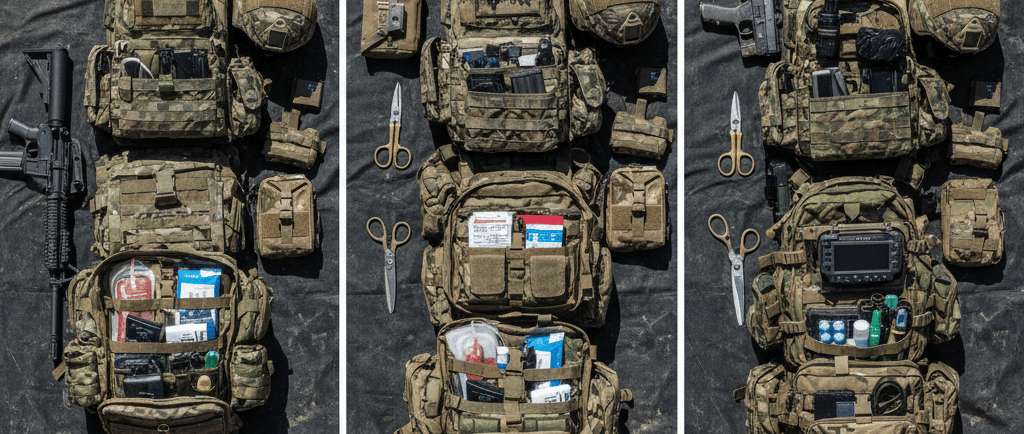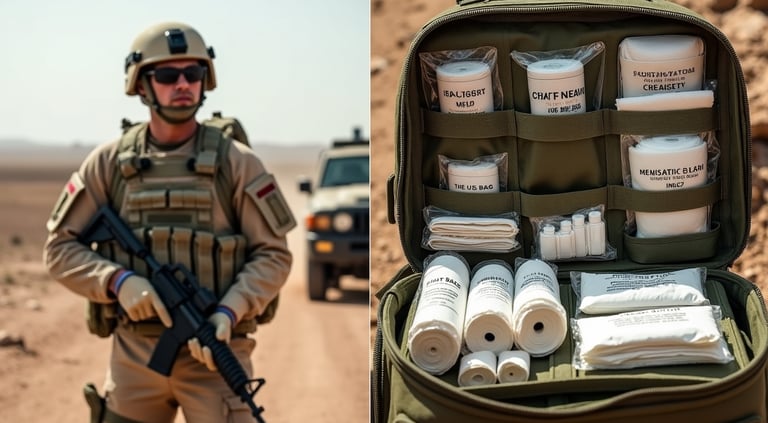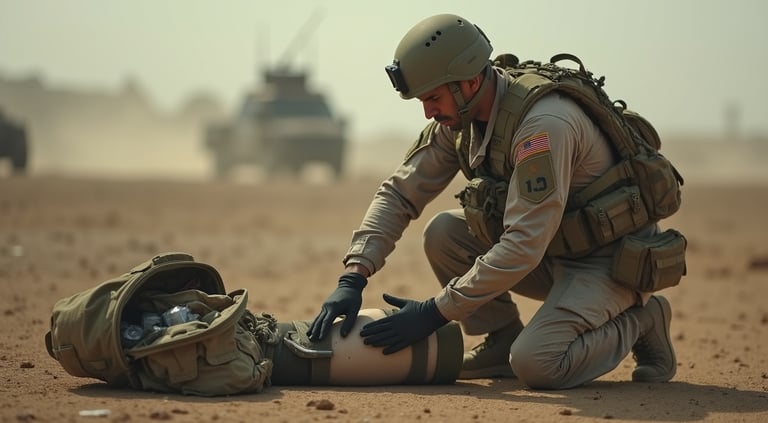Do Medics in the Military Wear the Same Gear? Uniforms, Equipment, and Role Variations Explained
Do military medics wear the same gear as combat troops? Uncover how their uniforms, equipment, and vital missions differ in the field.
10/14/20257 min read


It’s a common image from movies and TV: the lone soldier in a combat zone, a white arm band or helmet cross identifying them as the medic. You might see them wearing a standard uniform but carrying a noticeably larger bag. This raises a key question we hear all the time: Do medics in the military wear the same gear as the infantry, cavalry, or artillery soldiers they support?
The answer is yes and no. Military medics absolutely wear the same fundamental base uniform and protective equipment. They look like every other soldier when a firefight starts. However, their primary purpose—saving lives—requires them to break away completely with the specialized life-support tools they carry. This distinction is vital. The standard military medic gear is only the starting point. The real differences are found inside their bags and on their person, which varies widely depending on their service branch and specific role.
Table of Contents
The Short Answer: Same Base Uniform, Different Loadouts
Uniform and Armor: Why a Medic Looks Like a Soldier
Specialized Life-Saving: The Military Medic Equipment
Branch vs. Role: Army Medics vs. Navy Corpsmen Gear
Beyond the Kit: Do Combat Medics Carry Weapons?
The Future of Field Care: New Military Medic Gear
Frequently Asked Questions (FAQ)
The Short Answer: Same Base Uniform, Different Loadouts
If you’re wondering, do medics in the military wear the same gear as their fellow soldiers? The answer is generally yes for the uniform and personal protection, but a definite no for the equipment they carry to do their job. They wear the same camouflage uniform and body armor for military medics as the infantry to keep them from standing out and becoming a primary target. The key difference lies in the specialized supplies they pack. While a rifleman carries a bandolier of ammunition, the medic carries an aid bag stuffed with items like chest seals and hemostatic gauze. The real variance in military medic gear comes from their specific assignment—a line medic needs vastly different supplies than one serving at a base clinic. The slight combat medic uniform differences often boil down to specific patches or earned badges.
Uniform and Armor: Why a Medic Looks Like a Soldier?
If you look at an Army Combat Medic Specialist (68W) or a Navy Hospital Corpsman (HM) attached to a Marine unit, you will notice they wear the exact same camouflage uniform, be it OCP (Operational Camouflage Pattern) or MARPAT. They share the same rifle, helmet, and plate carrier.
This sameness is intentional and necessary. The body armor for military medics is the same because a bullet does not care about a job title. A medic is a combatant under attack and must be protected. There is no special, lighter armor for medical personnel. They need the same survival level as the soldiers they treat. In fact, many experienced veterans know that the medic is often carrying more weight due to their specialized bags. As someone who has spent time around these loadouts, I can tell you that assuming the heavy burden of medical gear often means sacrificing comfort in other areas. It’s a weight they accept, but it’s a constant battle with standard issue equipment. This is where personal modifications and quality after-market military medic gear become truly important for the individual.
The subtle combat medic uniform differences are minimal but important. The Army medic can earn the Combat Medical Badge (CMB), a silver medical cross over a wreath, worn above the name tag. This badge shows they delivered care while under fire. In garrison or hospital settings, their uniforms shift to standard service uniforms, or even scrubs in a clinic.
Specialized Life-Saving: The Military Medic Equipment
This is where the distinction is stark. While everyone carries an Individual First Aid Kit (IFAK), the medic's loadout is exponentially larger.
The first major difference is the main aid bag, often called a "Unit One Pack." This large backpack holds the tools to treat multiple casualties. The contents of the bag define the medic’s capability. What do Army medics carry in their aid bag? A whole pharmacy and surgical bay's worth of supplies:
Hemorrhage Control: Multiple tourniquets (CAT, SOFT-T), hemostatic agents like Combat Gauze (which promotes rapid clotting), and various trauma pressure dressings.
Airway/Respiration: Nasopharyngeal Airways (NPAs), chest decompression needles (for treating collapsed lungs), and chest seals for sealing sucking chest wounds.
Fluid Resuscitation: IV fluids, tubing, and even intraosseous (IO) drills to inject fluids directly into bone marrow when veins are inaccessible.
Advanced Items: Pain medications, advanced burn dressings, and sometimes even portable diagnostic equipment like a pulse oximeter.
This specialized medical gear for military medics moves far beyond basic first aid. It represents Tactical Combat Casualty Care (TCCC) at its highest level. Every item is military-grade, meaning it’s lighter, more durable, and often vacuum-sealed to survive harsh combat conditions. When you ask, do medics in the military wear the same gear, remember that their medical tools give them a powerful advantage in saving lives that other soldiers don't have.
Branch vs. Role: Army Medics vs. Navy Corpsmen Gear
The core skill set for trauma care is similar across the services, but the environment and parent branch create significant differences between Army medic and Corpsman gear.
Army 68W (Combat Medic Specialist): The Army medic equipment is typically focused on a ground combat scenario. Their loadout emphasizes mobility and point-of-injury care for an infantry or armor unit. The gear carried by 68W medic on a foot patrol prioritizes trauma and stabilization until Medical Evacuation (MEDEVAC) can happen.
Navy Corpsman (HM): A Corpsman's job is widely varied. A Corpsman on a ship will have a very different set of supplies than a Fleet Marine Force (FMF) Corpsman—the "Devil Doc"—who operates alongside the Marines. The FMF Corpsman’s Navy Corpsman gear will look very similar to the Army 68W's gear in a field environment, but their specific trauma protocols or the inclusion of ship-specific gear (like advanced dental or primary care supplies) will differ. Historically, Corpsmen working with the Marines were often given permission to wear Marine combat clothing, though their rank and service insignia remained Navy.
The most specialized of all are Special Operations Forces (SOF) Medics. These highly trained operators have an expanded scope of practice, able to perform advanced procedures in remote, isolated conditions. Their military medic gear is even more advanced, including full surgical kits, veterinary supplies, and extended-duration medications for complex, long-term missions. These elite medics often have greater latitude to modify their setups to increase effectiveness. For them, answering the question, do medics in the military wear the same gear, is definitely a "no," as their specialized training dictates a highly advanced and personalized kit.
Beyond the Kit: Do Combat Medics Carry Weapons?
Yes, they do. This is a topic that often surprises civilians. The idea of an unarmed medic is rooted in the Geneva Convention, which, in a perfect situation, protects dedicated medical personnel displaying the Red Cross from being targeted. However, modern warfare rarely offers a perfect situation.
The reality on the ground is that medics must defend themselves and their patients. The rule for U.S. forces is clear: do combat medics carry weapons? Absolutely. They carry a personal weapon, typically a sidearm or rifle, for self-defense and the protection of the wounded under their care. They are forbidden from taking an offensive posture, but defending their position to save a life is a non-negotiable part of their job. If a medic cannot protect the casualty collection point, they cannot complete their mission. That’s why their small arms are considered just as essential as their trauma shears. This answers the question of whether do medics in the military wear the same gear; when it comes to weapons, they do, because defense is necessary for survival.
The Future of Field Care: New Military Medic Gear
Military medic gear is constantly evolving. Lessons learned from recent conflicts drive innovation, pushing for smarter, lighter, and more capable equipment.
Today, there is a strong shift toward modular aid bags. These systems let the medic easily swap out pre-packed medical modules for specific missions, reducing unnecessary weight. Telemedicine is also a growing part of the equation, allowing medics in remote areas to consult with distant doctors for real-time guidance. Portable, handheld diagnostic tools, specialized anti-hypothermia kits, and even drone delivery of blood products are all examples of the specialized medical gear for military medics that will save more lives in the coming years. Getting better tools to the people who need them is always the goal. This continuing evolution means the differences in equipment will only increase over time, making it even less accurate to say, do medics in the military wear the same gear as everyone else.
Frequently Asked Questions (FAQ)
Q: What is the main difference between an Army 68W and a Navy Corpsman?
A: The primary difference lies in their service and their advanced training focus. The Army 68W (Combat Medic Specialist) is EMT-certified and serves with Army and sometimes Air Force units. The Navy Corpsman (HM) serves Navy and Marine Corps units ("Devil Docs"). Corpsmen often have a wider initial scope of practice or are trained to operate more independently in austere environments, especially those attached to Marine units. Their basic military medic gear is branch-specific, though their trauma supplies are similar.
Q: Do military medics wear a Red Cross on their uniform?
A: Not typically in active combat zones. While the Geneva Conventions grant protection to medical personnel wearing the Red Cross/Red Crescent, modern forces, especially in the US military, generally remove or use subdued markers to avoid making the medic a targeted enemy combatant, which unfortunately happens. A medic's protection comes from being non-combatants, but they often blend in with the standard uniform.
Q: Is the body armor for military medics different from a regular soldier’s?
A: No, when deployed, the body armor for military medics is generally the exact same level of plate carrier and protective inserts as the soldiers they support. The level of threat dictates the protection, and a medic's life is valued the same as any other soldier's in a tactical environment.
Q: What type of medical training do military medics receive?
A: All medics and Corpsmen receive intensive combat trauma care training based on the principles of Tactical Combat Casualty Care (TCCC). This training focuses heavily on immediate life-saving interventions like hemorrhage control and airway management. Army 68Ws earn a civilian EMT certification, which underscores their dual role in both combat and clinical environments. This level of training requires highly specific and reliable specialized medical gear for military medics.






